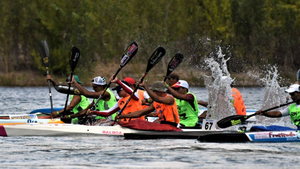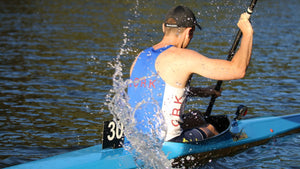Kayak and Surfski resistance training that will make you paddle faster

Increase your kayak power, speed and technique to take your paddling to the next level
Runners have hills, cyclists have hills as well as gears to add resistance to their training. Paddlers we have resistance too. Resistance training is highly beneficial to paddlers as it increases drag on the kayak or surfski which requires more work on your paddling muscles to move your kayak forward. Whether you paddle surfski, sprint or marathon kayaks there are benefits to adding resistance training to your paddling. In the gym weight training is great for paddlers to increase their strength but it doesn’t have the same specificity of working the paddle stroke muscles with additional resistance while balancing the kayak. To increase your maximum power for faster starts or to catch another runner in the ocean you and your coach will be able to put resistance to good use in your kayak training.
If used correctly there are several other benefits of paddling with resistance for surfski, sprint and marathon kayaking:
Technique
To use the words of Jimmy from My Kayak Coach “Balance = Power, and Power = Speed”. Training with a resistance strap reduces the gliding feeling of the ski or kayak underneath you which allows less concentration on balance. With the fear of falling in reduced paddlers can concentrate more on specific aspects of the catch, pull, recovery and setup phases of the kayak stroke to improve their technique and therefore speed.
Coaches will also notice that when their paddlers use resistance that weaknesses in their techniques are revealed more easily. Using resistance, the efficiency of a paddlers technique to pull on the paddle and feel like they can stand up off the footplate will be easily shown. Weaknesses such as this then translate to poor posture, low rotation and less than fluid kayak movement etc. The use of resistance slows the kayak down so proper technique, application of timely power and balance through to the next stroke can be worked on.
Power = Speed
When comparing World Champion paddlers to your average canoe club member, the champions are more efficient at applying energy through their kayak over time. This is using the whole body system of muscles and joints pulling on a paddle to act in unison, efficiently and maintain balance. This is the same principle that allows top paddlers to match our speed using less strokes to go the same speed over the same distance. The use of resistance straps in training will over time reduce the effort required to go the same speed and increase the maximum power you can apply to each stroke. This training gives paddlers the ease of catching the next swell, have a better marathon start or going faster over 200m, 500m or 1000m.
Time-saving
To apply the F.I.T.T principle of effective training there are only 4 levers that can be pulled in fitness: Frequency, Intensity, Time and Type of training. For those working fulltime, balancing family and friends as well as life’s other commitments time may be in short supply. So short paddle sessions can be optimised through keeping the intensity high with resistance.
Using resistance in your paddle training is a great way to make even short sessions count when used in parallel with varying the intervals within a session. Ask your coach for some ideas for short sessions or keep reading below.
Group management
This one is for the coaches out there. You’re bound to have had a group with just one or two paddlers who have far greater fitness than the rest of the group. Resistance straps are a great way to keep those faster paddlers with the group and working hard. They’ll stay with the group and be keen to take the resistance strap off by the end of the session to enjoy that free feeling of long glides across the water at the end of the session.
How to add resistance to your kayak or surfski training?
The Wash Rider Resistance Strap is the best way to add resistance to your hull. The Resistance Strap enables you to adjust different levels of resistance while on the water without the help of another paddler or coach in a motorboat. It quickly attaches and is removed from your ski or kayak. With an in front of the cockpit position allowing you to know what gear you are on and know if you have snagged anything on the strap. This keeps you and your kayak or surfski safely rather than trailing behind and catching on things behind your kayak.
Kayak Resistance Training Ideas
Coaches and their paddlers use resistance training in many ways. Some principles should be applied when using resistance;
- Always have a good warm-up to ensure the muscles are ready for the high-intensity work
- Keep the intervals short. Once your body fatigues you will lose the ideal technique
- Consult your coach about how you can best utilise resistance to achieve your paddling goals
To help interpret these sessions to use the method “Finding your maximum heart rate” in our blog Four of the best indoor kayaking sessions for ergometer training.
Training with resistance straps for starts or powering onto the next wave
This session can be done from either a rolling start or a stationary starting position and aims to build coordination and power to maximise each stroke over a 300m start distance. Take note of the difference in time and the number of strokes as you do this session over time to see improvement in your paddling efficiency at each level of resistance.

Resistance training for chasing downwind swells or kayak marathon breakaways
Similar to chasing runners or closing down a breakaway move in a kayak marathon this session is designed to condition your body to handle repeated efforts applying great power. Varying the level of resistance and duration of the effort to your ability level.

Resistance training to strengthen your paddling technique
Measure the number of strokes you take over 200 metres. This number becomes the maximum number of strokes you can take each 200m interval. Then complete the pyramid applying good technique and gliding your kayak or ski across the water between strokes to make the distance each time. When using resistance level 3 you’ll have to hold the setup position for what feels like an eternity between paddle strokes to make the distance. To add another dimension, agree on a limit to the number of strokes and race your friends for pride and glory.

Do you use resistance training with the paddlers you coach? Or have your own resistance training sessions? Share them in the comments for paddlers everywhere to enjoy.
- Kieran Babich







Comments 0